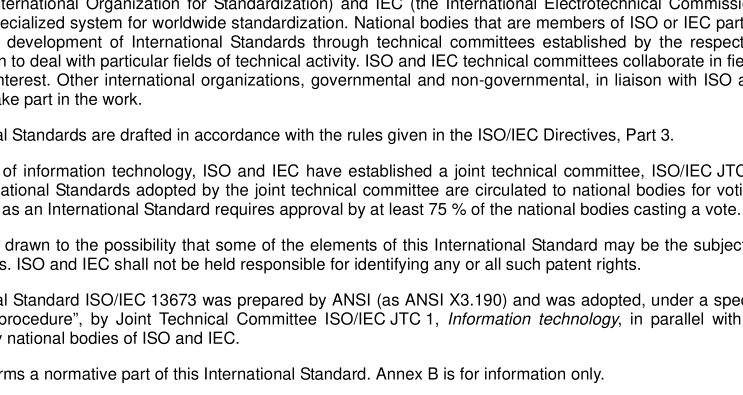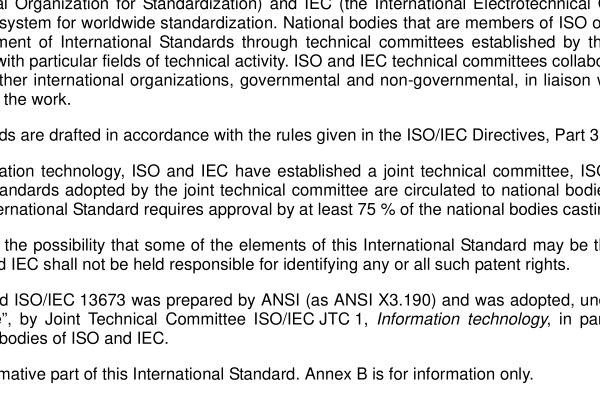ISO IEC 13673:2000 pdf download – Information technology — Document processing and related communication — Conformance testing for Standard Generalized Markup Language (SGML) systems.
4.2 application modules: Components of an SGML system other than the parser and entity manager. 4.3 effective edition: The current edition of a standard including any amendments, addenda, or other modifications. 4.4 Element Structure Information Set: Infor- mation comprising the element structure that is described by SGML markup (the element structure information set is defined in annex A). 4.5 ESIS: Element Structure Information Set. 4.6 equivalent SGML documents: SGML doc- uments that, when parsed with respect to identical DTDs and LPDs, have an identical ESIS. 4.7 internal entity: An entity whose replacement text appears in an entity declaration. 4.8 lexicographic order: An order in which dis- tinct strings are arranged by comparing successive letters. One string appears before another if it is a prefix of the second, or if, according to the following conventions, in the first position where they differ, the character in the first string precedes the char- acter in the second string. Printable characters precede nonprintable characters. One printable character precedes another if the ISO 646 charac- ter number of the first is smaller than the ISO 646 character number of the second. In particular, the space character precedes all other printable char- acters and any other printable character precedes a second one if the first precedes the second char- acter in the list of printable characters given in 4.1 4. A nonprintable character precedes another if its character number in the document character set is smaller than the character number of the second in the document character set. NOTE – For strings consisting only of printable char- acters, this order is independent of concrete syntax. 4.9 major SOO: A statement of objective for sev- eral related tests in a test suite. 4.10 markup-sensitive SGML application: An SGML application that can act on SGML markup as well as element structure. 4.11 minor SOO: A statement of objective that describes the particular principle of the SGML lan- guage that distinguishes an individual member of a group of related tests. 4.12 nonprintable character: A character that is not a printable character (see 4.1 4).
5 Use of SGML test suites Because of the wide variation possible in SGML systems, no single test suite is adequate for testing how well all SGML systems conform to the require- ments of ISO 8879. Some SGML systems produce SGML documents, others process SGML docu- ments to obtain various results, still others both read and produce SGML documents. Some sys- tems are restricted to documents with particular document type declarations, others can process arbitrary documents meeting the constraints of the system declaration . A test suite intended for a more general system contains test cases that can- not be processed by a more restrictive system; a test suite for a restrictive system does not ade- quately explore the capabilities of a more general one. NOTE – An SGML test suite indicates whether the modules of an SGML system that process SGML do so according to the specifications of ISO 8879. Test- ing a system’s SGML capabilities does not indicate whether it correctly performs a desired application in other respects. 5.1 Comprehensive test suites SGML test suites shall be comprehensive. A gen- eral-purpose SGML test suite shall provide tests that explore conformance to every required aspect of the SGML language and to every aspect of sup- ported optional features. Similarly, a test suite for a particular application shall provide tests to explore every aspect of the SGML language used in that application.
ISO IEC 13673:2000 pdf download – Information technology — Document processing and related communication — Conformance testing for Standard Generalized Markup Language (SGML) systems






